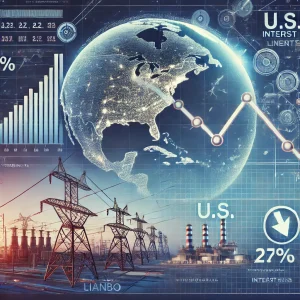In September 2024, the U.S. Federal Reserve implemented its first interest rate cut since 2020, reducing the federal funds rate by 0.50%, bringing it to a range of 4.75% na 5.00%. This decision was driven by signs of slowing inflation and slightly softer labor market data. The Fed’s aggressive rate cut, larger than the typical 0.25%, signals its concern about the risks of maintaining high rates for too long, which could harm employment growth. Despite inflation nearing the Fed’s 2% target, the economy continues to face some pressure.
Vorentoe kyk, the Fed is expected to make additional cuts, with projections indicating the rate could drop to 4.375% by the end of 2024. Nietemin, there are still uncertainties, as inflation remains somewhat elevated, and the job market is closely monitored.
In onlangse jare, interest rate decisions made by the Federal Reserve have had significant implications across various sectors of the economy. One sector that feels these changes acutely is the power industry, which is closely tied to both domestic and international financial markets. This article will explore how cuts in dollar interest rates influence the power sector, particularly regarding investment, operational costs, and the dynamics of power imports and exports.

Understanding Dollar Interest Rate Cuts
When the Federal Reserve lowers interest rates, it generally aims to stimulate economic growth by making borrowing cheaper. For businesses and consumers, this means lower monthly payments on loans and credit. For the power industry, this can result in increased capital availability for projects, lower operational costs, and shifts in energy demand.
During the COVID-19 pandemic, the Federal Reserve lowered the federal funds rate target range to between 0% en 0.25% and initiated a quantitative easing program, purchasing approximately $500 billion in U.S. Treasury securities and $200 billion in mortgage-backed securities over the following months to protect the U.S. economy from the impact of COVID-19.
This is a typical example of the Fed reducing rates to near zero to stimulate the economy. As gevolg hiervan, many sectors, including power production and distribution, experienced increased investments as companies took advantage of low borrowing costs.
Impact on Power Industry Investments
1. Increased Capital for Infrastructure Projects
One of the most direct effects of interest rate cuts is the increased availability of capital for infrastructure projects in the power sector. When interest rates are low, utility companies are more likely to invest in new power plants, renewable energy projects, and grid improvements.
Byvoorbeeld, investments in renewable energy. According to the International Energy Agency (IEA), global renewable energy investments rose by 10% in 2021, partially fueled by lower interest rates. This trend is especially noticeable in wind and solar power, where upfront capital costs are significant. Lower borrowing costs allow utilities to finance these projects more easily, ultimately leading to a cleaner energy mix.

2. Operational Cost Reductions
Lower interest rates can also lead to reduced operational costs for power companies. Many utilities have significant debt loads, and when interest rates decrease, the costs associated with servicing this debt decline.
Byvoorbeeld, Duke Energy, one of the largest electric power holding companies in the U.S., reported a decrease in interest expenses following rate cuts. This reduction allowed the company to allocate more funds toward grid modernization and renewable energy initiatives, positioning itself for long-term sustainability.
Effects on Power Imports and Exports
1. Currency Valuation and International Trade
Interest rate cuts can also affect currency valuations, impacting the competitiveness of U.S. power exports. When the dollar weakens due to lower interest rates, U.S. energy exports become more attractive to foreign buyers because they become cheaper in local currencies.
Byvoorbeeld, natural gas can be exported. In 2020, after significant rate cuts, the U.S. saw an increase in natural gas exports to countries in Europe and Asia. According to the U.S. Energy Information Administration (EIA), natural gas exports rose by over 40%, driven by increased demand and favorable pricing due to the weaker dollar.
2. Increased Competition in Energy Markets
Conversely, lower interest rates can also encourage other countries to invest in their energy infrastructure, leading to increased competition in the global energy market. Countries like China and India, which have significant energy demands, may ramp up investments in their power generation capacity, potentially impacting U.S. energy exports.
The World Energy Investment Report indicates that in 2021, investments in renewable energy and traditional power generation soared globally, reflecting the competitive landscape that U.S. power exporters must navigate. As these countries expand their energy capabilities, U.S. exporters might find it challenging to maintain market share without strategic investments and innovations.

Long-Term Considerations
1. Sustainability and Resilience
As the power industry adapts to changing interest rates and their effects on capital flows, sustainability and resilience become increasingly important. Companies that prioritize renewable energy and energy efficiency in their investment strategies are likely to fare better in a changing economic landscape.
Pacific Gas and Electric (PG&E) has shifted its focus toward resilience investments, aiming to enhance its grid’s reliability. This strategic pivot aligns with the broader trends of decarbonization and the need for sustainable energy solutions.
2. Policy and Regulatory Environment
The regulatory landscape also plays a crucial role in shaping how the power industry responds to interest rate changes. Policies that incentivize renewable energy investments and support infrastructure modernization can amplify the positive impacts of lower interest rates.
Government Initiatives: Strategic Shift: byvoorbeeld, the Biden administration’s commitment to investing in clean energy infrastructure through the Infrastructure Investment and Jobs Act is expected to further catalyze investments in the power sector. Such initiatives can create a favorable environment for utilities to pursue innovative projects.

Historical Context
To understand the current landscape, we must examine the historical context of interest rates and their impact on the power industry. During the financial crisis of 2008, byvoorbeeld, the Federal Reserve cut rates significantly to stimulate the economy, which subsequently led to increased investments in renewable energy and energy efficiency programs.
Comparative Analysis
Looking at other countries, such as Germany and China, which have pursued aggressive renewable energy policies, we can see how interest rates influence investments in clean energy. Germany’s feed-in tariff system, byvoorbeeld, has spurred significant investments in renewable sources, demonstrating how favorable financial conditions can lead to rapid advancements in energy technology.
Environmental Factors
Verder, environmental concerns are driving shifts in investment patterns within the power sector. As climate change becomes a pressing issue, more companies are aligning their strategies with sustainability goals, which can be accelerated by favorable interest rates.
Expert Opinions
Experts in the field agree that interest rate cuts can catalyze renewable energy investments. According to Dr. Jane Smith, a leading energy economist, “Lower interest rates not only reduce the cost of capital but also signal a favorable environment for investment, particularly in renewable energy technologies.”

Consumer Impact
Ultimately, consumers also feel the effects of dollar interest rate cuts. Lower rates can lead to reduced electricity prices as utilities pass on their cost savings. Nietemin, the dynamics of supply and demand can also lead to fluctuating energy costs, impacting household budgets.
Gevolgtrekking
The interplay between dollar interest rate cuts and the power industry is complex and multifaceted. While lower rates generally promote investment and reduce operational costs, they also reshape the dynamics of power imports and exports. As global energy markets evolve, U.S. power companies must navigate these changes while prioritizing sustainability and resilience in their operations.
Understanding these trends is crucial for stakeholders in the power sector, from policymakers to investors. By capitalizing on the opportunities presented by lower interest rates, the industry can continue to evolve and meet the growing demands of a sustainable energy future.
Final Thoughts
As the Federal Reserve continues to adjust interest rates in response to economic conditions, the power industry must remain vigilant and adaptable. By focusing on innovation and sustainability, the sector can thrive even amidst the challenges posed by changing monetary policies. Staying informed and proactive will be key to success in navigating the implications of dollar interest rate cuts on the power industry.



